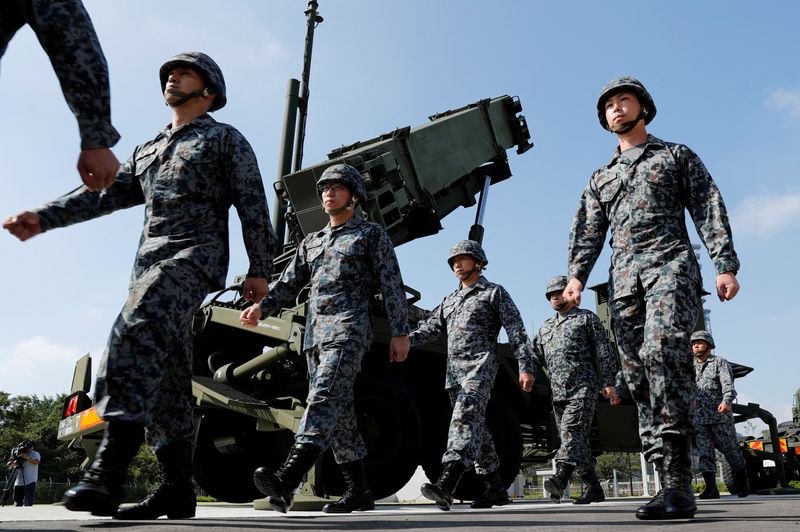By Nobuhiro Kubo and Tim Kelly
TOKYO (Reuters) -A U.S. plan to make use of Japanese factories to spice up manufacturing of Patriot air defence missiles – utilized by Ukraine to defend towards Russian assaults – is being delayed by a scarcity of a essential element manufactured by Boeing (NYSE:), 4 sources mentioned.
Japan’s Mitsubishi Heavy Industries (MHI) already makes about 30 PAC-3 missiles every year underneath licence from defence contractor Lockheed Martin (NYSE:) and may enhance that quantity to about 60, two Japanese authorities officers and two trade sources informed Reuters.
The U.S. hopes to extend manufacturing from about 500 a 12 months to greater than 750 per 12 months globally as quickly as potential, an individual acquainted with this system mentioned. However no enlargement in any respect will probably be potential in Japan with out extra provides of the missiles’ seekers, which information them within the closing levels of flight, the officers and trade sources mentioned.
“It could take several years before MHI is able to raise output” due to the scarcity, mentioned one of many trade sources, who just like the others declined to be recognized as a result of they aren’t authorised to talk to the media.
The manufacturing snag in Japan reveals the challenges Washington faces in plugging industrial assist from its world allies into its complicated provide chains.
Boeing final 12 months started increasing its seeker manufacturing facility in the USA to extend manufacturing by 30%, though the extra strains will not function till 2027. The corporate didn’t say final 12 months what number of have been produced, however famous it had simply delivered its 5,000th.
A Boeing consultant referred inquiries to Lockheed Martin, the prime contractor for the interceptor.
Lockheed Martin has mentioned it’s rising its U.S. output of Patriot interceptors from 500 to 650 by 2027. Every prices about $4 million.
Even when sufficient seekers can be found, increasing annual PAC-3 manufacturing in Japan past 60 would require MHI to construct extra capability.
In its 2022 plan to double army spending, Japan’s authorities mentioned it might provide monetary assist to defence firms that needed to broaden manufacturing. These subsidies, nevertheless, solely apply to gear destined for the nation’s Self Protection Forces and never exports.
That implies that MHI or the USA must stump up the cash to pay for a brand new PAC-3 manufacturing facility, which might price tens of thousands and thousands of {dollars} or extra, one of many Japanese authorities sources mentioned.
“The Indo-Pacific is a large area of focus for the U.S. and our allies and strategically postured capabilities in the region are critical to support deterrence and maintain readiness,” Lockheed Martin mentioned in an e mail, referring questions on PAC-3 manufacturing in Japan to the Japanese and U.S. governments, and MHI.
Japan’s Ministry of Protection declined to remark. MHI declined to remark.
A U.S. defence official mentioned a $4.5 billion contract signed in June with the U.S. Military – the Patriot system’s main buyer – marked the start of a ramp-up in manufacturing of each missiles and seekers.
Overseas and defence ministers from Japan and the USA are set to fulfill in Tokyo this month for talks which might be anticipated to incorporate deepening industrial cooperation on defence. The Patriot challenge is seen as a key a part of that effort.
Even with assist from allies, provide chain bottlenecks complicate U.S. efforts to provide Ukraine’s demand for munitions, together with air defence programs that may thwart Russian assaults.
Within the deadliest wave of air strikes in months, a Russian missile in July struck a kids’s hospital, killing at the least 41 civilians.
In December 2023, Japan eased army export guidelines to permit it to assist replenish U.S. Patriot missile shares, which had been tapped to assist Ukraine.
U.S. Ambassador to Japan Rahm Emanuel, who known as {that a} “historic decision”, has been a number one proponent of deeper army industrial ties with Japan that would ease the pressure on U.S. defence contractors.

U.S. President Joe Biden and Japanese Prime Minister Fumio Kishida agreed in April to deepen defence trade cooperation.
In an opinion piece printed by the Wall Road Journal two months after that assembly, Emanuel described a shrunken U.S. army industrial complicated as a “weak link” that had been uncovered by the Ukraine warfare and the Center East battle.




